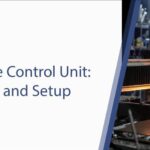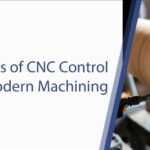If you’re just getting started with CNC G Codes, you’re in the right place. In 2025, shops that streamline toolpaths, feeds, and speeds with clean, well-structured CNC G Codes can achieve significant reductions in cycle time and waste.
This beginner-friendly guide explains what CNC G Codes are, how they work, and how to write them correctly—plus plenty of G-code programming examples and practical tips tailored for hobbyists, small manufacturers, and entry-level engineers using Radonix CNC controllers.
We’ll cover the fundamentals, basic G-code commands, real-world programming workflows, common mistakes to avoid, and the latest 2025 trends like AI-driven CAM and sustainable, energy-efficient machining.
What Are CNC G Codes? Fundamentals Explained
CNC G Codes are the core programming instructions that tell your machine how to move. Each “G” command sets a mode or motion type—linear moves, arcs, plane selection, units, and more—allowing you to transform CAD/CAM intent into precise, repeatable toolpaths on mills, lathes, routers, lasers, and beyond. A short history and context
- Origin: G-code has roots in standardized numerical control from the mid-20th century, evolving into formats like ISO 6983.
- Purpose: It’s the language that specifies motion and machining strategies, whether you’re using CNC milling G codes for 3-axis contouring or lathe G codes for turning and threading.
- Ecosystem: You’ll see variations across controllers (e.g., Fanuc G codes), but the core concepts translate well between brands with minor adjustments to syntax and modal behavior.
G-code vs. M-code
- G-code: Governs motion and preparatory functions (e.g., G00 rapid, G01 linear feed, G02/G03 arcs, G90/G91 positioning modes).
- M-code: Handles machine-level functions (e.g., M03 spindle on clockwise, M08 coolant on, M06 tool change). Think of M codes as machine controls and G codes as motion logic within your CNC codes program.
Why beginners should care
- G-code syntax is straightforward once you know the patterns: a block-based program, line by line, with modal states that persist until changed.
- Knowing basic G-code commands helps you read and tweak CAM output safely, hit tolerance, and prevent crashes—critical skills whether you’re a maker or managing a small production cell.
- If you’re using Radonix CNC controllers, understanding CNC G Codes gives you the confidence to pair powerful control features with efficient toolpaths.
For a deeper primer on controllers themselves, see: How CNC Controller Works: Full Guide to Precision Control on the Radonix blog.
Essential Basic G-Code Commands for Beginners
Below are the foundational CNC G Codes you’ll use daily. Keep this table handy as a quick-reference sheet. These basic G-code commands appear across many controllers, with minor syntax differences. Always check your machine’s manual.
| Command | Description | Example Use Case |
| G00 | Rapid traverse (non-cutting move) | Move quickly to a safe clearance: G00 X0 Y0 Z5 |
| G01 | Linear interpolation (cutting move) | Straight-line cut at feed: G01 X50 Y0 F300 |
| G02 | Clockwise arc | Circular pocket CW: G02 X0 Y0 I-10 J0 |
| G03 | Counterclockwise arc | Circular pocket CCW: G03 X0 Y0 I10 J0 |
| G17/G18/G19 | Plane selection (XY/XZ/YZ) | Set plane for arcs: G17 for milling on XY |
| G20/G21 | Units (inch/mm) | Metric programming: G21 |
| G28 | Return to machine home | Safe return after op: G28 Z0 |
| G40/G41/G42 | Cutter comp off/left/right | Profile with tool radius comp: G41 |
| G54–G59 | Work coordinate systems | Set part zero: G54 |
| G90/G91 | Absolute/incremental positioning | Absolute: G90, step moves: G91 |
| G94/G95 | Feed per minute/per revolution | Mills: G94, Lathes: G95 |
| G81–G89 | Drilling cycles (canned) | Peck drilling: G83 Z-15 R2 Q2 F120 |
| G96/G97 (lathe) | CSS on/off (constant surface speed) | G96 S180 m/min; G97 S1200 RPM |
| G98/G99 | Return levels in cycles | G98 return to initial; G99 return to R |
Notes:
- The combination of G17/G18/G19 and G02/G03 matters: your plane defines arc interpretation.
- With cutter comp (G41/G42), give a proper lead-in/lead-out so the control can offset the tool without gouging.
- Many cnc codes are modal: once set (e.g., G01), they stay active until you change them.
G Code Programming Examples: Hands-On Tutorials
This section is your mini CNC programming tutorial with G-code programming examples you can adapt. Always run in air first, use a safe Z, and verify units and work offsets.Example 1: Straight line facing cut (mill) Goal: Face a small aluminum block front edge at Z=-0.2 mm depth.Steps:
- Set safety line and modes: metric, absolute, XY plane.
- Call work offset G54 and select the tool.
- Rapid to clearance, then feed into the cut.
- Retract and return home.
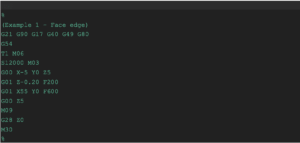
Key learning:
- G21 sets metric; G90 sets absolute positioning.
- Use G00 only for clearance moves. Use G01 with feed to cut.
Example 2: Circular pocket with helical interpolation (mill) Goal: Mill a 20 mm diameter, 3 mm deep pocket.Steps:
- Start above the pocket center.
- Ramp in with a helical path using G03 and I/J for center.
- Spiral to full diameter and depth.
- Finish with a cleanup circle.
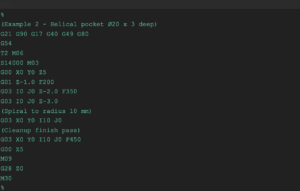
Tips:
- Some controls prefer R for arc radius; others prefer I/J relative to start.
- Maintain a constant step-down per revolution to avoid tool overload.
Example 3: Drilling pattern with a canned cycle (mill) Goal: Drill 4 holes on a rectangular pattern with a G81 cycle, 10 mm deep.Steps:
- Set R-plane and cycle parameters.
- Use G98 or G99 depending on return level preference.
- Position to each hole and call the same cycle.
- Cancel with G80.

Notes:
- G98 returns to the initial Z after each hole; G99 returns to the R-plane. Choose based on your clearance needs.
- Replace G81 with G83 peck drilling when chips pack.
Example 4: External threading on a lathe (G76) Goal: Cut an M20 x 2.5 external thread using a standard threading cycle.Steps:
- Set CSS if desired, and G95 for feed per revolution.
- Define thread parameters with G76 (format varies by controller).
- Start at safe Z, then execute the cycle.
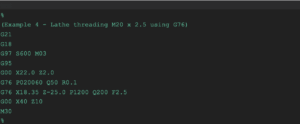
Threading reminders:
- Lathe G codes often differ from mill codes; check your machine’s G76 syntax.
- G95 ensures feed is per revolution—critical for synchronization.
- For Fanuc G codes, verify the two-line G76 format vs. one-line variants.
Common Mistakes in CNC G Codes and How to Avoid Them
Avoid these frequent pitfalls when writing or editing CNC G Codes:
- Absolute vs. incremental confusion: G90 vs. G91 mix-ups cause runaway moves. Confirm your positioning mode at program start.
- Plane selection errors: Using G02/G03 arcs with the wrong plane (G17/G18/G19) produces unexpected paths.
- Units mismatch: CAM posts in inches (G20) but the machine expects mm (G21), or vice versa. Set units explicitly.
- Missing tool length or wear offsets: Activate the correct length (e.g., G43 Hxx) and cutter comp (G41/G42) with proper lead-in/out.
- Unsafe rapids: Always retract to a known safe Z before lateral rapids, and use clearance planes with G98/G99 in cycles.
- Incorrect I/J or R in arcs: Understand your controller’s arc center conventions and quadrants.
- Feed mode mistakes: Mills often use G94; lathes commonly use G95 for threading. Wrong feed mode ruins the surface finish or the tool.
- Modal “leftovers”: Cancel cycles with G80; reset states at program end; and clear cutter comp with G40.
- No dry run: Always verify with a graphical simulation and a high-Z air cut on the real machine.
2025 Trends: Evolving CNC G Codes with AI and Sustainability
AI-driven CAM and automation
- Modern CAM now leverages AI to propose toolpaths that reduce air cutting, stabilize engagement, and auto-tune feeds and speeds. The result: more efficient CNC G Codes with fewer manual edits and improved tool life.
- Expect tighter integration between CAD, CAM, and the controller HMI—automated probing routines, smarter rest machining, and instant post-processed G-code programming examples that are validated for your machine’s kinematics.
Sustainability and energy-efficient programming
- Shorter rapids, optimized stepdowns, and constant-tool-engagement strategies reduce spindle load and power consumption.
- Minimizing retracts and non-cutting moves saves energy and time. Small changes in your CNC G Codes—like better entry strategies and reduced air time—compound across batches.
- Tool life tracking and wear-aware feeds lower scrap rates and consumable waste.
Radonix innovations and your workflow
- Pair intelligent CAM with robust control hardware for the best results.
Conclusion
Mastering CNC G Codes gives you control, speed, and confidence.
Start with basic G-code commands, learn how modal states work, and practice with small edits to CAM output.
Use the G-code programming examples in this CNC programming tutorial as a foundation—and then build from there with probing, cycles, and comp.
Whether you’re machining prototypes at home or scaling production, clean, well-structured CNC G Codes reduce cycle time, improve surface finish, and prevent costly mistakes.
FAQ
Q1: What is G00 in CNC G codes?
A: G00 is rapid traverse. The machine moves at maximum speed to the target coordinates without cutting. Use G00 only for safe clearance moves above the part and fixtures, and confirm your Z height and work offset first.
Q2: What’s the difference between G-code and M-code?
A: G-code controls motion and preparatory modes (linear, arc, units, planes). M-code controls machine functions (spindle on, coolant, tool change). You’ll use both together in CNC G-code programs to cut safely and efficiently.
Q3: Are Fanuc G-codes the same on every machine?
A: Fanuc G codes are broadly similar, but there are differences in cycles, parameters, canned cycle formats, and options. Always check your machine’s manual and post-processor notes before running a program generated by CAM.
Q4: How do I test new G-code safely?
A: Simulate first, then run a dry test above the part with reduced feed override. Start with a safe start line (units, plane, modes), confirm work offsets and tool lengths, and watch for modal conflicts or missing cancels like G80 or G40.
Q5: Which CNC G codes should beginners learn first?
A: Start with G00, G01, G02/G03, G17/G18/G19, G20/G21, G54, G90/G91, and a few drilling cycles like G81/G83. These cover most milling tasks. Then explore cutter compensation (G41/G42) and, for lathes, threading cycles like G76.
Contact Us:
- E-Mail: info@radonix.com
- Phone: +90 (553) 920 5500




